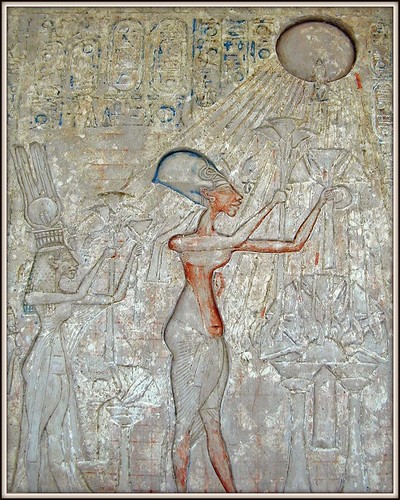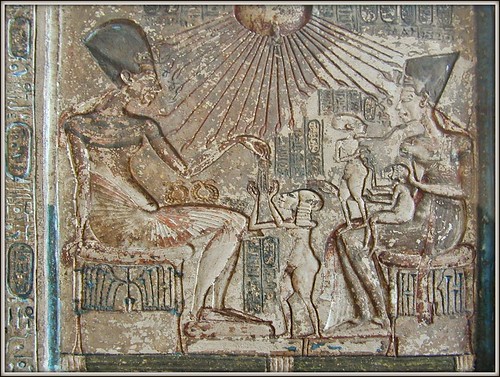Some scholars speculate that she became a pharaoh following Akhenaten's death, but evidence for this tumultuous period of Egyptian history is limited. Even though there have been reports of the queen's mummy being found, as of 2012, none of these discoveries has been substantiated. This famous beauty remains one of Egypt's mysteries, and the queen's final years, death and resting place remain a secret.
<H2>Nefertiti in History</H2> ca. 1370 BC- ca. 1330 BC
The queen, whose name translates as 'the beautiful one has come,' was the chief wife of Akhenaten. She was also called Neferneferuaten-Nefertiti. This name bears a strong connection to an unknown pharaoh who appeared after Akhenaten's death.
Pharaoh Akhenaten ruled in the 18th Dynasty, during the tumultuous and vibrant Amarna period. He pushed Egypt into monotheism, deposing the pantheon of gods that had been ascendent in Egypt during the reigns of previous rulers. The young pharaoh attested that Aten was the sole god, replacing the chief god Amun. Akhenaten raised Aten, a sun god, to the position of his country's one god.
 |
la salle d'Akhenaton (1356-1340 av J.C.) (Musée du Caire) by Dalbera |
The stylized art of the period departed from the more formal art of previous reigns, leaving stiff body lines behind and becoming softer, more sensuous and full of unusual elements that seem to be exaggerations, such as elongated skulls and a feminine shape to the pharaoh's body. Although elongated skulls created by binding are known in Africa, the remains from this period in ancient Egypt don't show evidence of elongated skulls.
The full-hipped, soft-bellied shape of Akhenaten led to speculations that he may have had a medical condition, been physically androgynous or even female. History indicates he fathered six daughters with Nefertiti, in addition to children with other wives.
Art depicting Akhenaten and Nefertiti include affectionate scenes of the couple and natural family scenes with their daughters. The warmth and quiet domesticity of the scenes contrasts with the formal mood of previous royal portraits.
Given his lasting influence, it's noteworthy that Akhenaten reigned for only 17 years. After his death, Akhenaten was reviled as the heretic pharaoh and the pantheon of Egypt's gods regained their former power. Ancient Egyptians destroyed or defaced some of the images of this unusual pharaoh.
The facts about Nefertiti are that she became Akhenaten's queen and bore six daughters. The family moved from Thebes to the new royal seat in Amarna between the births of the third and fourth daughters, according to History.com. Her history becomes murky in the 12th year of Akhenaten's reign. Scholars continue to debate whether she died, became a co-regent or might even have been banished.
The Queen's Last Years
One of the most intriguing speculations about the queen's life is that she may have been a little-known pharaoh who ruled after Akhenaten. The personal name of this pharaoh was Nefernefruaten, according to an article in a 2001 issue of the "National Geographic." Some inscriptions suggest the queen became co-regent with Akhenaten in the 12th year of his reign, although this theory is contested by some scholars. Another theory holds that she was the little known pharaoh Smenkhkare, and that she may have ruled with Akhenaten in traditional royal male clothing, according to the Egypt State Information Service.
In one relief, she's depicted holding enemies by the hair and smiting them with a mace, a motif typical of art featuring a pharaoh. She also performs priestly duties. Based on these indications, her public roles went beyond traditional queenship in Egypt.
Although the evidence is slim for the theory of Nefertiti reigning as a pharaoh, it's possible. There were cases of women ruling in Egypt and taking on the titles and trappings of kingship, including Hatshepsut who wore a ceremonial false beard and a king's headdress in official portraits and sculptures, and Cleopatra, a Ptolemy who became the last pharaoh of Egypt. To date, there's so little known about two minor kings who followed Akhenaten and preceded Tut that it's difficult to weigh the case.
Her Dress and Figure
The famous bust of Nefertiti portrays her wearing a tapered blue headdress unlike that of any other queen or pharaoh. It's flat on top and flares slightly as it rises from the queen's forehead. It would originally have had a rearing cobra jutting from the front of the crown. In paintings, the queen's dress is the sheer linen gown that was a staple of royal women's fashion. Her gowns drape her slender and feminine figure.In some poses, it falls open, revealing her legs.
 |
| Akhenaton, Nefertiti and their daughters (Cairo Museum) by Dalbera |
In one scene she has on an elaborate crown called a "hem hem" crown, and the sheer top part of her gown is off-the-shoulder, leaving one arm bare and the other showing through folds of sheer fabric.
<h2>Gowns, Jewelry, Accessories, Headdresses, Crowns and Hairstyles:</h2>
In many depictions the queen wears a sheath dress or a sheer pleated gown with loose sleeves above the elbow. In the image above and in a statue of her with the pharaoh, she wears a contrasting tie that belts the gown below the bust and falls loose in two long tails down the front of the dress. In certain images it appears she's wearing a long contrasting scarf over her shoulder that falls in two long streamers down the gown. In the statue shown on the SUNY Oneonta site, she wears a wide, jeweled collar and sandals.
She often wears the flat-topped blue crown, but is also shown wearing a plumed headdress with a sun disk. In addition to the wide jeweled color with multi-color stones, she sometimes wears wide matching armbands positioned between the wrist and elbow. (See the images on the Saint Louis University page for the wig, bracelets and different headdresses and crowns).
She sometimes appears with her hair up, tucked under the blue crown, and at other times has on a full wig in an above-the shoulder length.
Further Reading:
Nefertiti: Egypt's Sun Queen, Joyce A. Tyldesley
Egypt State Information Service:
"Some have suggested that the royal couple had a falling out and Nefertiti was banished in disgrace to her palace, Aten’s Castle. Others are quite convinced that Nefertiti changed her name to Smenkhkare, adopted the guise of a man and ruled as co-regent with her husband."
TIME: Nefertiti Found?
"Things apparently got dicey for Nefertiti sometime after the 12th year of Akhenaten's 17-year reign. She vanished from the historical record about that time. She may have died or, Egyptologists speculate, may have served as co-regent with her husband and after his death, as Pharaoh ..."
National Geographic: Pharaohs of the Sun
"Now some suspect there were actually two pharaohs with the throne name Ankhkheprure. The other pharaoh's personal name was Nefernefruaten, which is identical to a longer variation of Nefertiti's name. Did Nefertiti survive and rule briefly as pharaoh?"
History.com: Nefertiti by Joyce Tyldesley
"In the Theban temple known as Hwt-Benben [...] Nefertiti played a more prominent role, usurping kingly privileges in order to serve as a priest and offer to the Aton. A group of blocks recovered from Karnak [...] shows Nefertiti participating in the ritual smiting of the female enemies of Egypt."
SUNY Oneonta: Fashion -- Egypt 3000 - 300, (See Slide no. 25)
http://employees.oneonta.edu/angellkg/egypt.html
Saint Louis University: Egyptian Kings and Queens: Nefertiti
http://euler.slu.edu/~bart/egyptianhtml/kings%20and%20Queens/Nefertiti.html
Author's Note: Variations in spellings are common. Akhenaten's name sometimes appears as Akhenaton. Royal ancient Egyptians often had several names, adding to the confusion. As the National Geographic article cited above explains, the pharaohs had a throne name and a personal name. Akhenaten was originally known as Amenhotep III. He was the son of Amenhotep IV, who ruled Egypt for 37 years. Aten, the name of a sun god, is sometimes written Aton.
Updated 1-14-2013
Copyright Travis Arts 2012, 2013 All rights reserved.

Thank you for this page! I'm home schooled and my co-op is having and Egyptian feast where we will dress up as Pharaohs, Queens or Gods. I'm going to be Nefertiti and have to make a costume so this was very helpful! If you have anything else on what she wore I would love to know it :)
ReplyDeletecool
ReplyDelete